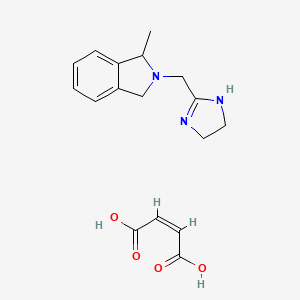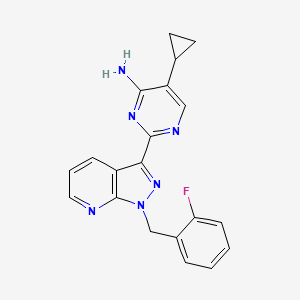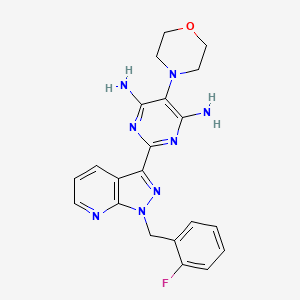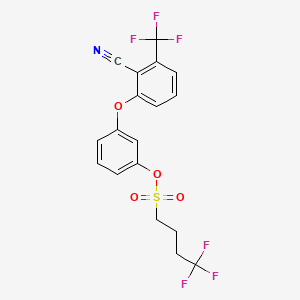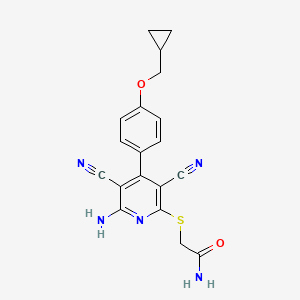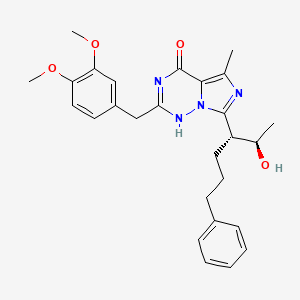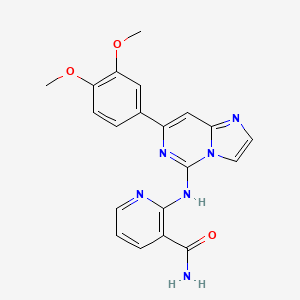
溴隐亭
描述
溴隐亭是一种麦角碱衍生物,也是一种多巴胺激动剂。它最初以帕洛德的品牌名称销售,此后又以各种其他名称出售。 溴隐亭主要用于治疗垂体肿瘤、帕金森病、高泌乳素血症、神经性恶性综合征和 2 型糖尿病 。 它于 1968 年获得专利,并于 1975 年获得医疗使用批准 .
科学研究应用
溴隐亭具有广泛的科学研究应用:
化学: 它被用作分析化学中的参考化合物,用于开发新的分析方法.
生物学: 溴隐亭用于研究多巴胺受体功能和信号通路。
医学: 它广泛用于治疗高泌乳素血症、帕金森病和 2 型糖尿病等疾病
工业: 溴隐亭用于制药行业开发新药和制剂.
作用机制
溴隐亭通过作为多巴胺 D2 受体激动剂发挥作用。它与大脑中的多巴胺受体结合,抑制垂体释放催乳素。这种机制有利于治疗高泌乳素血症和帕金森病等疾病。 在 2 型糖尿病的情况下,溴隐亭通过增加下丘脑多巴胺水平来帮助改善血糖控制,这反过来又会降低胰岛素抵抗和肝脏葡萄糖生成 .
类似化合物:
卡麦角林: 另一种用于治疗高泌乳素血症和帕金森病的多巴胺激动剂。
培高利特: 用于治疗帕金森病。
喹戈利特: 一种非麦角碱多巴胺激动剂,用于治疗高泌乳素血症.
比较: 溴隐亭的快速释放制剂使其独特,从而可以快速起效。它还被用作 2 型糖尿病的辅助治疗方法,这是其他多巴胺激动剂不常见的一种特征。 另一方面,卡麦角林的半衰期更长,由于其给药频率更低,因此通常更受欢迎 .
生化分析
Biochemical Properties
Bromocriptine is a partial agonist of the dopamine D2 receptor . It also interacts with other dopamine receptors and with various serotonin and adrenergic receptors . Bromocriptine has additionally been found to inhibit the release of glutamate by reversing the GLT1 glutamate transporter .
Cellular Effects
Bromocriptine blocks the release of a hormone called prolactin from the pituitary gland . Prolactin affects the menstrual cycle and milk production . Bromocriptine is used to treat certain menstrual problems in women and stops milk production in some men and women who have abnormal milk leakage .
Molecular Mechanism
Bromocriptine stimulates centrally-located dopaminergic receptors resulting in a number of pharmacologic effects . Five dopamine receptor types from two dopaminergic subfamilies have been identified . The dopaminergic D1 receptor subfamily consists of D1 and D5 subreceptors, which are associated with dyskinesias .
Temporal Effects in Laboratory Settings
In laboratory settings, bromocriptine use was associated with a modest but statistically significant decline in temperature, with nadir at 72 h post initiation . This suggests that the effects of bromocriptine can change over time in a laboratory setting.
Dosage Effects in Animal Models
In animal models, studies conducted on bromocriptine have shown that stimulating D2 receptors may enhance working memory in rodents, whereas inhibiting these receptors could have the opposite effect, reducing working memory performance .
Metabolic Pathways
Bromocriptine is completely metabolized by the liver, primarily by hydrolysis of the amide bond to produce lysergic acid and a peptide fragment, both inactive and non-toxic . Bromocriptine is metabolized by cytochrome P450 3A4 and excreted primarily in the feces via biliary secretion .
Transport and Distribution
Bromocriptine is rapidly absorbed (about 28% to 37% of the total dose) after oral administration . It is metabolized by cytochrome P450 3A4 and excreted primarily in the feces via biliary secretion .
准备方法
合成路线和反应条件: 溴隐亭通过一系列化学反应从麦角生物碱开始合成。溴隐亭甲磺酸盐的制备涉及将溴隐亭溶解在甲醇中,然后加入甲磺酸水溶液。 将混合物搅拌、冷却、过滤,并用乙醇重结晶以获得溴隐亭甲磺酸盐 .
工业生产方法: 溴隐亭的工业生产遵循类似的步骤,但规模更大。 该过程涉及对反应条件(如温度和 pH 值)的精确控制,以确保最终产物的高产率和纯度 .
化学反应分析
反应类型: 溴隐亭会经历各种化学反应,包括:
氧化: 溴隐亭可以在特定条件下被氧化以形成不同的代谢产物。
还原: 还原反应可以改变分子中的溴原子。
常用试剂和条件:
氧化: 常用的氧化剂包括高锰酸钾和过氧化氢。
还原: 可以使用锂铝氢化物等还原剂。
取代: 可以使用碘化钠等试剂进行卤素交换反应.
主要产物: 从这些反应中形成的主要产物取决于所使用的特定条件和试剂。 例如,氧化可以导致形成各种羟基化的代谢产物 .
相似化合物的比较
Cabergoline: Another dopamine agonist used to treat hyperprolactinemia and Parkinson’s disease.
Pergolide: Used in the treatment of Parkinson’s disease.
Quinagolide: A non-ergoline dopamine agonist used to treat hyperprolactinemia.
Comparison: Bromocriptine is unique in its quick-release formulation, which allows for rapid onset of action. It is also used as an adjunct therapy for type 2 diabetes, a feature not commonly seen with other dopamine agonists. Cabergoline, on the other hand, has a longer half-life and is often preferred for its less frequent dosing schedule .
属性
IUPAC Name |
(6aR,9R)-5-bromo-N-[(1S,2S,4R,7S)-2-hydroxy-7-(2-methylpropyl)-5,8-dioxo-4-propan-2-yl-3-oxa-6,9-diazatricyclo[7.3.0.02,6]dodecan-4-yl]-7-methyl-6,6a,8,9-tetrahydro-4H-indolo[4,3-fg]quinoline-9-carboxamide | |
|---|---|---|
| Source | PubChem | |
| URL | https://pubchem.ncbi.nlm.nih.gov | |
| Description | Data deposited in or computed by PubChem | |
InChI |
InChI=1S/C32H40BrN5O5/c1-16(2)12-24-29(40)37-11-7-10-25(37)32(42)38(24)30(41)31(43-32,17(3)4)35-28(39)18-13-20-19-8-6-9-22-26(19)21(27(33)34-22)14-23(20)36(5)15-18/h6,8-9,13,16-18,23-25,34,42H,7,10-12,14-15H2,1-5H3,(H,35,39)/t18-,23-,24+,25+,31-,32+/m1/s1 | |
| Source | PubChem | |
| URL | https://pubchem.ncbi.nlm.nih.gov | |
| Description | Data deposited in or computed by PubChem | |
InChI Key |
OZVBMTJYIDMWIL-AYFBDAFISA-N | |
| Source | PubChem | |
| URL | https://pubchem.ncbi.nlm.nih.gov | |
| Description | Data deposited in or computed by PubChem | |
Canonical SMILES |
CC(C)CC1C(=O)N2CCCC2C3(N1C(=O)C(O3)(C(C)C)NC(=O)C4CN(C5CC6=C(NC7=CC=CC(=C67)C5=C4)Br)C)O | |
| Source | PubChem | |
| URL | https://pubchem.ncbi.nlm.nih.gov | |
| Description | Data deposited in or computed by PubChem | |
Isomeric SMILES |
CC(C)C[C@H]1C(=O)N2CCC[C@H]2[C@]3(N1C(=O)[C@](O3)(C(C)C)NC(=O)[C@H]4CN([C@@H]5CC6=C(NC7=CC=CC(=C67)C5=C4)Br)C)O | |
| Source | PubChem | |
| URL | https://pubchem.ncbi.nlm.nih.gov | |
| Description | Data deposited in or computed by PubChem | |
Molecular Formula |
C32H40BrN5O5 | |
| Source | PubChem | |
| URL | https://pubchem.ncbi.nlm.nih.gov | |
| Description | Data deposited in or computed by PubChem | |
Related CAS |
22260-51-1 (mesylate (salt)) | |
| Record name | Bromocriptine [USAN:INN:BAN] | |
| Source | ChemIDplus | |
| URL | https://pubchem.ncbi.nlm.nih.gov/substance/?source=chemidplus&sourceid=0025614033 | |
| Description | ChemIDplus is a free, web search system that provides access to the structure and nomenclature authority files used for the identification of chemical substances cited in National Library of Medicine (NLM) databases, including the TOXNET system. | |
DSSTOX Substance ID |
DTXSID1022687 | |
| Record name | Bromocriptine | |
| Source | EPA DSSTox | |
| URL | https://comptox.epa.gov/dashboard/DTXSID1022687 | |
| Description | DSSTox provides a high quality public chemistry resource for supporting improved predictive toxicology. | |
Molecular Weight |
654.6 g/mol | |
| Source | PubChem | |
| URL | https://pubchem.ncbi.nlm.nih.gov | |
| Description | Data deposited in or computed by PubChem | |
Physical Description |
Solid | |
| Record name | Bromocriptine | |
| Source | Human Metabolome Database (HMDB) | |
| URL | http://www.hmdb.ca/metabolites/HMDB0015331 | |
| Description | The Human Metabolome Database (HMDB) is a freely available electronic database containing detailed information about small molecule metabolites found in the human body. | |
| Explanation | HMDB is offered to the public as a freely available resource. Use and re-distribution of the data, in whole or in part, for commercial purposes requires explicit permission of the authors and explicit acknowledgment of the source material (HMDB) and the original publication (see the HMDB citing page). We ask that users who download significant portions of the database cite the HMDB paper in any resulting publications. | |
Solubility |
8.58e-02 g/L | |
| Record name | Bromocriptine | |
| Source | Human Metabolome Database (HMDB) | |
| URL | http://www.hmdb.ca/metabolites/HMDB0015331 | |
| Description | The Human Metabolome Database (HMDB) is a freely available electronic database containing detailed information about small molecule metabolites found in the human body. | |
| Explanation | HMDB is offered to the public as a freely available resource. Use and re-distribution of the data, in whole or in part, for commercial purposes requires explicit permission of the authors and explicit acknowledgment of the source material (HMDB) and the original publication (see the HMDB citing page). We ask that users who download significant portions of the database cite the HMDB paper in any resulting publications. | |
Mechanism of Action |
The dopamine D2 receptor is a 7-transmembrane G-protein coupled receptor associated with Gi proteins. In lactotrophs, stimulation of dopamine D2 receptor causes inhibition of adenylyl cyclase, which decreases intracellular cAMP concentrations and blocks IP3-dependent release of Ca2+ from intracellular stores. Decreases in intracellular calcium levels may also be brought about via inhibition of calcium influx through voltage-gated calcium channels, rather than via inhibition of adenylyl cyclase. Additionally, receptor activation blocks phosphorylation of p42/p44 MAPK and decreases MAPK/ERK kinase phosphorylation. Inhibition of MAPK appears to be mediated by c-Raf and B-Raf-dependent inhibition of MAPK/ERK kinase. Dopamine-stimulated growth hormone release from the pituitary gland is mediated by a decrease in intracellular calcium influx through voltage-gated calcium channels rather than via adenylyl cyclase inhibition. Stimulation of dopamine D2 receptors in the nigrostriatal pathway leads to improvements in coordinated muscle activity in those with movement disorders. | |
| Record name | Bromocriptine | |
| Source | DrugBank | |
| URL | https://www.drugbank.ca/drugs/DB01200 | |
| Description | The DrugBank database is a unique bioinformatics and cheminformatics resource that combines detailed drug (i.e. chemical, pharmacological and pharmaceutical) data with comprehensive drug target (i.e. sequence, structure, and pathway) information. | |
| Explanation | Creative Common's Attribution-NonCommercial 4.0 International License (http://creativecommons.org/licenses/by-nc/4.0/legalcode) | |
CAS No. |
25614-03-3 | |
| Record name | (+)-Bromocriptine | |
| Source | CAS Common Chemistry | |
| URL | https://commonchemistry.cas.org/detail?cas_rn=25614-03-3 | |
| Description | CAS Common Chemistry is an open community resource for accessing chemical information. Nearly 500,000 chemical substances from CAS REGISTRY cover areas of community interest, including common and frequently regulated chemicals, and those relevant to high school and undergraduate chemistry classes. This chemical information, curated by our expert scientists, is provided in alignment with our mission as a division of the American Chemical Society. | |
| Explanation | The data from CAS Common Chemistry is provided under a CC-BY-NC 4.0 license, unless otherwise stated. | |
| Record name | Bromocriptine [USAN:INN:BAN] | |
| Source | ChemIDplus | |
| URL | https://pubchem.ncbi.nlm.nih.gov/substance/?source=chemidplus&sourceid=0025614033 | |
| Description | ChemIDplus is a free, web search system that provides access to the structure and nomenclature authority files used for the identification of chemical substances cited in National Library of Medicine (NLM) databases, including the TOXNET system. | |
| Record name | Bromocriptine | |
| Source | DrugBank | |
| URL | https://www.drugbank.ca/drugs/DB01200 | |
| Description | The DrugBank database is a unique bioinformatics and cheminformatics resource that combines detailed drug (i.e. chemical, pharmacological and pharmaceutical) data with comprehensive drug target (i.e. sequence, structure, and pathway) information. | |
| Explanation | Creative Common's Attribution-NonCommercial 4.0 International License (http://creativecommons.org/licenses/by-nc/4.0/legalcode) | |
| Record name | Bromocriptine | |
| Source | EPA DSSTox | |
| URL | https://comptox.epa.gov/dashboard/DTXSID1022687 | |
| Description | DSSTox provides a high quality public chemistry resource for supporting improved predictive toxicology. | |
| Record name | Bromocriptine | |
| Source | European Chemicals Agency (ECHA) | |
| URL | https://echa.europa.eu/substance-information/-/substanceinfo/100.042.829 | |
| Description | The European Chemicals Agency (ECHA) is an agency of the European Union which is the driving force among regulatory authorities in implementing the EU's groundbreaking chemicals legislation for the benefit of human health and the environment as well as for innovation and competitiveness. | |
| Explanation | Use of the information, documents and data from the ECHA website is subject to the terms and conditions of this Legal Notice, and subject to other binding limitations provided for under applicable law, the information, documents and data made available on the ECHA website may be reproduced, distributed and/or used, totally or in part, for non-commercial purposes provided that ECHA is acknowledged as the source: "Source: European Chemicals Agency, http://echa.europa.eu/". Such acknowledgement must be included in each copy of the material. ECHA permits and encourages organisations and individuals to create links to the ECHA website under the following cumulative conditions: Links can only be made to webpages that provide a link to the Legal Notice page. | |
| Record name | BROMOCRIPTINE | |
| Source | FDA Global Substance Registration System (GSRS) | |
| URL | https://gsrs.ncats.nih.gov/ginas/app/beta/substances/3A64E3G5ZO | |
| Description | The FDA Global Substance Registration System (GSRS) enables the efficient and accurate exchange of information on what substances are in regulated products. Instead of relying on names, which vary across regulatory domains, countries, and regions, the GSRS knowledge base makes it possible for substances to be defined by standardized, scientific descriptions. | |
| Explanation | Unless otherwise noted, the contents of the FDA website (www.fda.gov), both text and graphics, are not copyrighted. They are in the public domain and may be republished, reprinted and otherwise used freely by anyone without the need to obtain permission from FDA. Credit to the U.S. Food and Drug Administration as the source is appreciated but not required. | |
| Record name | Bromocriptine | |
| Source | Human Metabolome Database (HMDB) | |
| URL | http://www.hmdb.ca/metabolites/HMDB0015331 | |
| Description | The Human Metabolome Database (HMDB) is a freely available electronic database containing detailed information about small molecule metabolites found in the human body. | |
| Explanation | HMDB is offered to the public as a freely available resource. Use and re-distribution of the data, in whole or in part, for commercial purposes requires explicit permission of the authors and explicit acknowledgment of the source material (HMDB) and the original publication (see the HMDB citing page). We ask that users who download significant portions of the database cite the HMDB paper in any resulting publications. | |
Melting Point |
215-218 | |
| Record name | Bromocriptine | |
| Source | DrugBank | |
| URL | https://www.drugbank.ca/drugs/DB01200 | |
| Description | The DrugBank database is a unique bioinformatics and cheminformatics resource that combines detailed drug (i.e. chemical, pharmacological and pharmaceutical) data with comprehensive drug target (i.e. sequence, structure, and pathway) information. | |
| Explanation | Creative Common's Attribution-NonCommercial 4.0 International License (http://creativecommons.org/licenses/by-nc/4.0/legalcode) | |
Retrosynthesis Analysis
AI-Powered Synthesis Planning: Our tool employs the Template_relevance Pistachio, Template_relevance Bkms_metabolic, Template_relevance Pistachio_ringbreaker, Template_relevance Reaxys, Template_relevance Reaxys_biocatalysis model, leveraging a vast database of chemical reactions to predict feasible synthetic routes.
One-Step Synthesis Focus: Specifically designed for one-step synthesis, it provides concise and direct routes for your target compounds, streamlining the synthesis process.
Accurate Predictions: Utilizing the extensive PISTACHIO, BKMS_METABOLIC, PISTACHIO_RINGBREAKER, REAXYS, REAXYS_BIOCATALYSIS database, our tool offers high-accuracy predictions, reflecting the latest in chemical research and data.
Strategy Settings
| Precursor scoring | Relevance Heuristic |
|---|---|
| Min. plausibility | 0.01 |
| Model | Template_relevance |
| Template Set | Pistachio/Bkms_metabolic/Pistachio_ringbreaker/Reaxys/Reaxys_biocatalysis |
| Top-N result to add to graph | 6 |
Feasible Synthetic Routes
体外研究产品的免责声明和信息
请注意,BenchChem 上展示的所有文章和产品信息仅供信息参考。 BenchChem 上可购买的产品专为体外研究设计,这些研究在生物体外进行。体外研究,源自拉丁语 "in glass",涉及在受控实验室环境中使用细胞或组织进行的实验。重要的是要注意,这些产品没有被归类为药物或药品,他们没有得到 FDA 的批准,用于预防、治疗或治愈任何医疗状况、疾病或疾病。我们必须强调,将这些产品以任何形式引入人类或动物的身体都是法律严格禁止的。遵守这些指南对确保研究和实验的法律和道德标准的符合性至关重要。



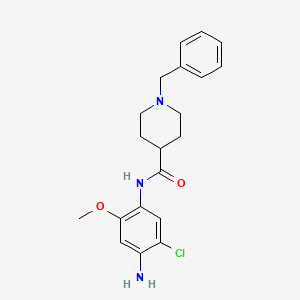
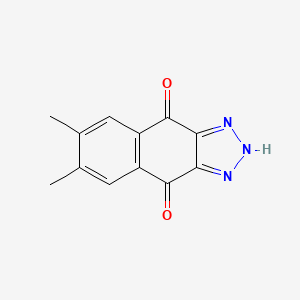

![(2S)-1-[(2S)-2-[[5-(2,3-dihydro-1-benzofuran-2-yl)-1-ethoxy-1-oxopentan-2-yl]amino]propanoyl]pyrrolidine-2-carboxylic acid](/img/structure/B1667802.png)
